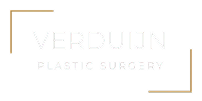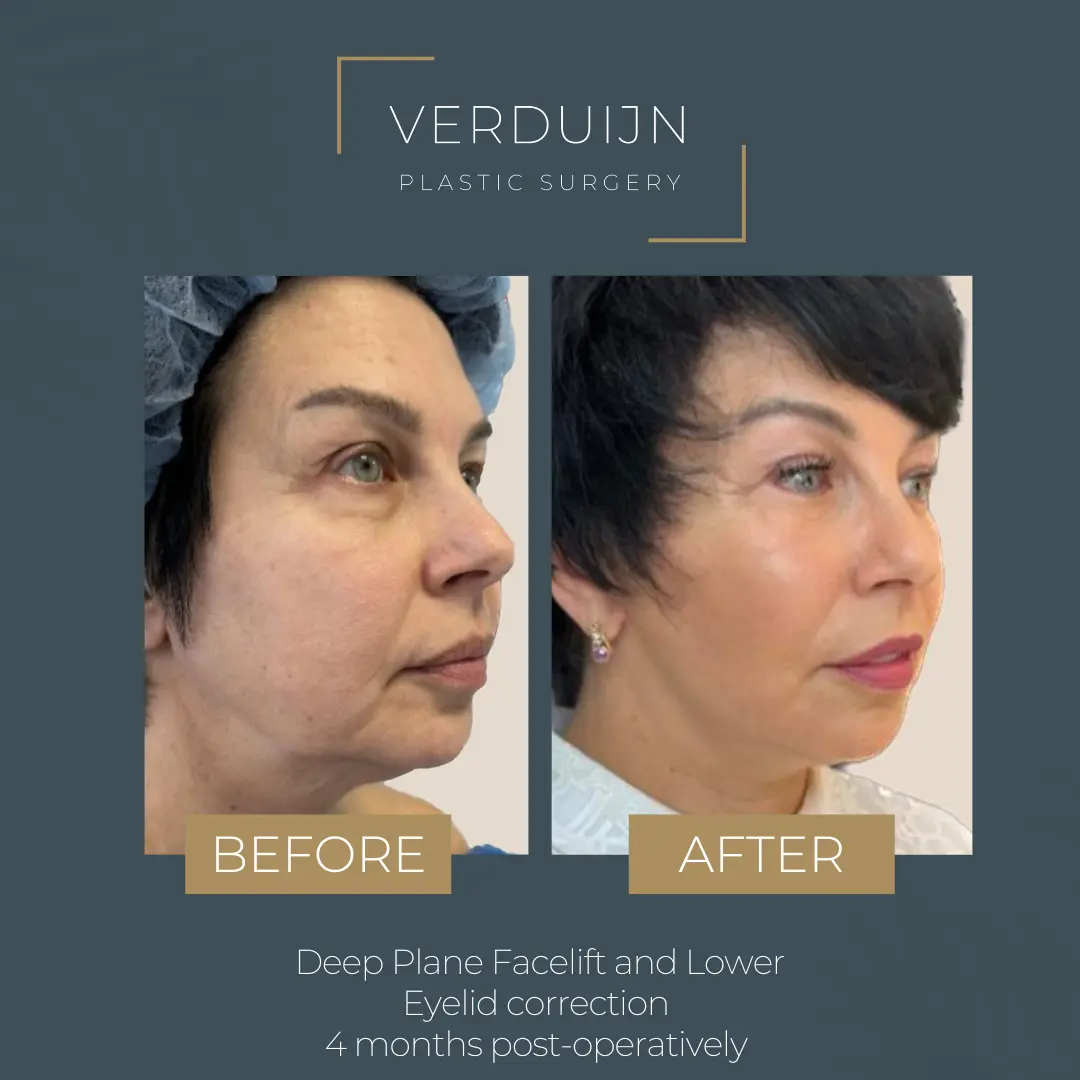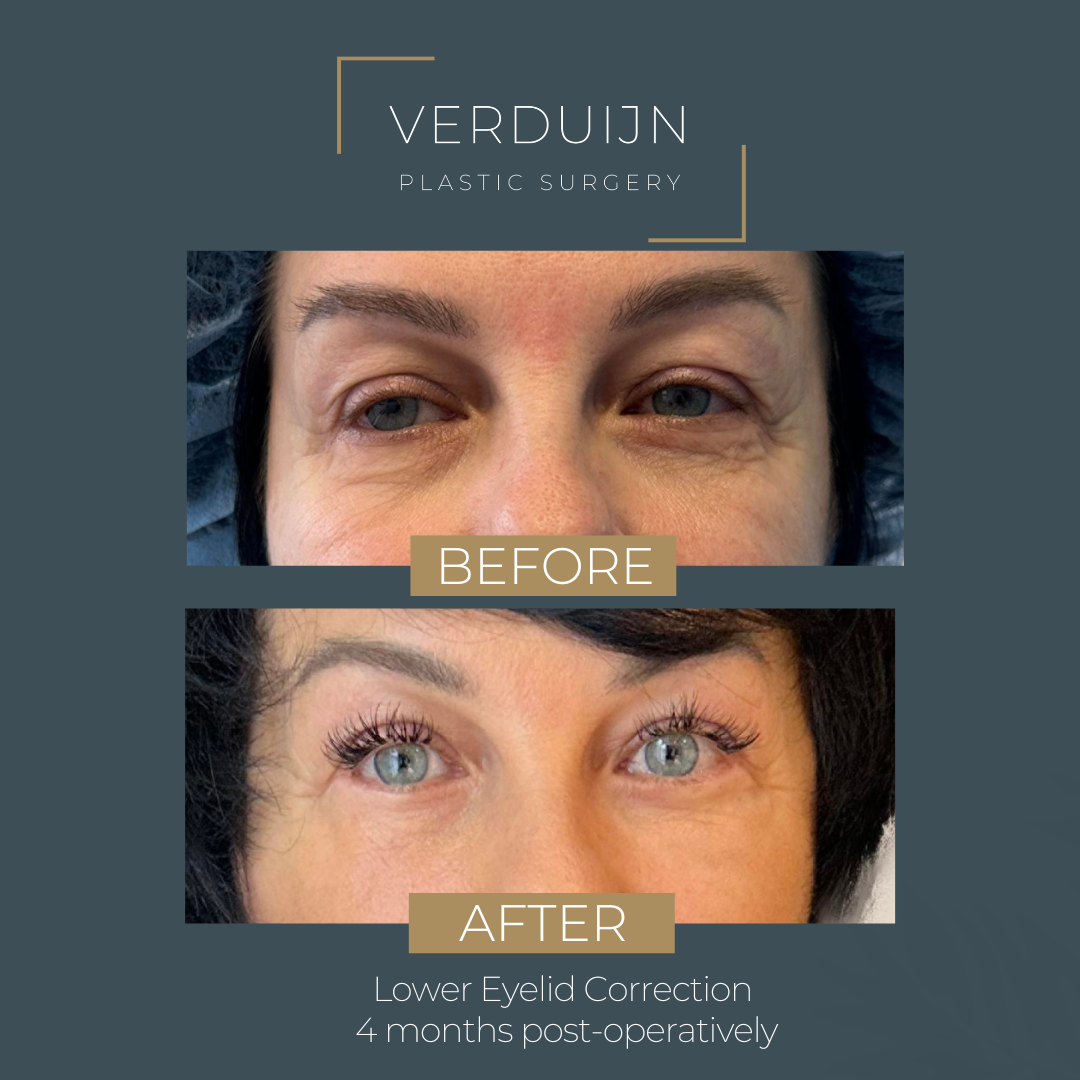Facelift door dé specialist van Nederland
Dr. Verduijn combineert zijn expertise als hoofd Plastische Chirurgie LUMC met een artistiek oog voor natuurlijke verjonging. Ontdek de mogelijkheden van professionele facelift chirurgie en ervaar de luxe van boutique behandeling.

Natuurlijke Facelift: Esthetische Chirurgie
Een facelift is meer dan een cosmetische ingreep. Het is het terugwinnen van je natuurlijke uitstraling en zelfvertrouwen. Dr. Verduijn begrijpt dat elke vrouw uniek is. Zijn filosofie draait om natuurlijke verjonging waarbij je eigen karakter behouden blijft. Met jarenlange ervaring in zowel reconstructieve als esthetische chirurgie beheerst hij de meest verfijnde technieken. Van traditionele facelift tot moderne, geavanceerde technieken. Jouw wensen en anatomie bepalen samen de ideale aanpak. Het resultaat: een frisse, jeugdige uitstraling die volledig bij je past.
ONZE Facelift behandelingen
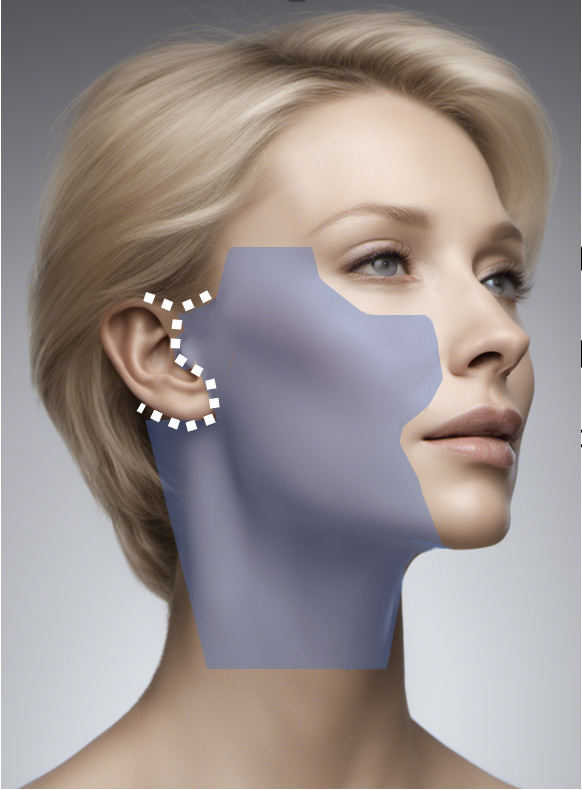
Deep plane facelift
The Deep Plane Facelift rejuvenates the midface, restores lost facial volume, elevates cheeks, and corrects nasolabial folds and marionette lines, crafting a naturally rejuvenated appearance.
It also lifts the muscles and skin around the jawline for a flawless profile.
Unlike traditional methods, this Facelift technique provides a long-lasting stunning transformation by also addressing the deeper tissues.

En Bloc Facelift
De Enbloc Facelift is een zorgvuldig afgestemde behandeling voor verslapte huid en kaaklijn, zonder dat er sprake is van diepe neus lipplooien of verlies van volume in het middengezicht. Deze techniek verfrist je uitstraling via een discreet litteken en geeft een natuurlijk en harmonieus resultaat.
De Deep Plane Facelift biedt een krachtigere oplossing voor neus lipplooien en marionetlijnen, omdat hierbij de dieper gelegen weefsels worden vrijgemaakt en hergepositioneerd. Hierdoor is de verbetering uitgebreider en langduriger.

Deep Plane Facelift en halslift
De combinatie van een Deep Plane Facelift en een halslift zorgt voor een complete verjonging van zowel het gezicht als de hals. Door deze twee technieken samen toe te passen ontstaat een jeugdige uitstraling met een strakke kaaklijn en een elegante halscontour.
Het corrigeren van verslapte huid en huidoverschot in gezicht en hals, in combinatie met het aanpakken van de onderliggende spieren, vetstructuren en andere weefsels, levert langdurige natuurlijke resultaten op met minimale littekens.
UW ZORGEN VERDIENEN AANDACHT
Onze behandelingen zijn minimaal zichtbaar, en langdurig effect.
Elke behandeling begint met aandacht. Van het eerste consult tot de nazorg.
Boutique-ervaring met volledige discretie
Uw eigen gezicht, maar jonger. Dr. Verduijn richt zich op verfijnde, natuurlijke resultaten die uw uitstraling versterken.
Ideale kandidaat
GOEDE KANDIDATEN VOOR EEN FACELIFT ZIJN MANNEN EN VROUWEN DIE TEKENEN VAN VEROUDERING IN HUN GEZICHT BEGINNEN TE ZIEN.
veelvoorkomende signalen en omstandigheden die kunnen aangeven dat een facelift geschikt voor je kan zijn.
1. Verslapte gezichtshuid
Als de huid rondom de wangen, kaaklijn en hals begint te verslappen kan een facelift helpen om een jeugdiger en frisser uiterlijk te herstellen.
2. Diepe plooien in het gezicht
Neus lipplooien en marionetlijnen verdiepen naarmate de huid verder verslapt. Deze kunnen effectief worden behandeld met een Deep Plane Facelift.
3. Verlies van volume in het middengezicht
Wanneer het volumeverlies in het middengezicht je een oudere of vermoeide uitstraling geeft kan een Deep Plane Facelift het verloren volume herstellen.
4. Rimpels
Een facelift kan de rimpels in het gezicht verzachten. Een combinatie met laserbehandelingen kan worden ingezet om fijne lijntjes verder te verbeteren.
5. Wens voor een frissere en jeugdiger uitstraling
Wanneer je ontevreden bent over het huidige uiterlijk van je gezicht en graag een jeugdiger en frisser resultaat wilt kan een facelift een transformatieve behandeling zijn.
6. Niet chirurgische behandelingen zijn niet langer voldoende
Injectables zoals Botox en fillers kunnen tijdelijk verbeteren maar zijn soms niet effectief genoeg bij gevorderde huidverslapping of volumeverlies. In dat geval kan een chirurgische facelift een betere optie zijn.
7. Revision Facelift
Bij onbevredigende resultaten of complicaties na een eerdere facelift kan een revisie ingreep noodzakelijk zijn.
Het is belangrijk om een gekwalificeerd en ervaren plastisch chirurg te raadplegen om vast te stellen of je een geschikte kandidaat bent. Tijdens het consult beoordeel ik jouw gezichtsstructuur bespreek ik je wensen en verwachtingen en adviseer ik de meest passende aanpak voor het gewenste resultaat.
De ideale patiënt is in goede gezondheid en vermijdt alcohol en tabak voor en na de ingreep omdat dit de wondgenezing en het uiteindelijke resultaat aanzienlijk beïnvloedt.
Voor optimale en langdurige resultaten is het bovendien belangrijk om voor de operatie op het gewenste gewicht te zijn.
Facelift voor en na
Bewonder de natuurlijke transformaties van onze facelift patiënten. Elke behandeling toont Dr. Verduijn's expertise in het creëren van jeugdige elegantie zonder kunstmatige uitstraling. Resultaten die je zelfvertrouwen versterken.
Tijdlijn / Werkwijze
Samen zullen we uw wensen bespreken. Geleid door uw unieke voorkeuren zal ik uw gezicht nauwgezet analyseren. Op basis van uw wensen en de nuances van uw gezicht zullen we de verschillende behandelopties doornemen. Vertrouwen is essentieel voor mij, en daarom zal ik ruim de tijd besteden aan het beantwoorden van uw vragen, het bespreken van het traject, waarbij ik de verwachte resultaten en eventuele risico’s transparant bespreek. Het is belangrijk om op één lijn te zitten! Mogelijke operatiedata en offertes worden gegeven door mijn assistent-schoonheidscoach.
Onze toewijding aan discretie, uw veiligheid, comfort en uitstekende resultaten drijft ons ertoe u uitgebreide begeleiding te bieden in de dagen voorafgaand aan uw halslift en de cruciale herstelperiode die volgt. Een medische evaluatie en preoperatief medicatieadvies zorgen voor een soepele operatieve ervaring. Aanpassingen in levensstijl zoals gehydrateerd blijven en het vermijden van roken en overmatig alcoholgebruik, dragen bij aan sneller herstel en betere resultaten.
Operatie
Op de dag van de operatie zal ik u ontmoeten vóór de operatie om nogmaals samen de geplande ingreep door te nemen. Het is belangrijk om de pre-operatieve vasteninstructies die u heeft ontvangen op te volgen voor uw veiligheid tijdens de narcose. Trek comfortabele kleding aan en vermijd het dragen van make-up en sieraden. Als u wakker wordt, heeft u een verband en wordt u naar uw kamer gebracht om te herstellen. Een verpleegkundige staat paraat om u tijdens uw verblijf te assisteren.
Herstel
Meestal wordt een halslift uitgevoerd in dagbehandeling, tenzij uw gezondheid langere opname vereist. Geef uw lichaam voldoende tijd om te herstellen. Rust met uw hoofd omhoog en vermijd zware activiteiten in de eerste dagen na de operatie om uw herstel te versnellen. Volg het voorgeschreven medicatieregime en de huidverzorgingsinstructies nauwgezet. Dit bevordert genezing, minimaliseert ongemak en ondersteunt optimale litteken genezing. Blijf prioriteit geven aan een voedzaam dieet en blijf gehydrateerd. Het heeft de voorkeur om iemand aan uw zijde te hebben om uw overgang naar huis te vergemakkelijken en u te helpen met dagelijkse taken.
Samen met mijn toegewijde team sta ik voor u klaar om u bij elke stap te ondersteunen, van het eerste consult tot uw postoperatieve reis. Woon alle geplande vervolgafspraken bij. Deze bezoeken stellen ons in staat uw voortgang te monitoren, eventuele zorgen aan te pakken en u te begeleiden naar een succesvol herstel. Binnen de eerste 2 weken na de operatie worden wondinspecties en het verwijderen van hechtingen uitgevoerd. Na 3 weken komen we weer samen om uw herstel te beoordelen, en 6 maanden later zullen de littekens gaan vervagen, en is het een goed moment om uw transformatie te evalueren!
Plan een consult
Plan een discreet consult waarin we uw wensen bespreken en ik de mogelijkheden uitleg. Samen bepalen we of deze techniek geschikt is voor uw unieke situatie.
Facelift Kosten en Veel Gestelde Vragen

Facelift kosten variëren afhankelijk van de gekozen techniek en complexiteit. Tijdens je consult krijg je een transparante prijsindicatie op maat voor jouw situatie.

Dr. Verduijn biedt verschillende facelift technieken: van mini facelift tot volledige SMAS facelift. De keuze hangt af van je anatomie, leeftijd en gewenste resultaat. Tijdens consult adviseert hij de beste aanpak.

Na 2-3 weken ben je weer sociaal actief. Zwelling en blauwe plekken verdwijnen geleidelijk. Het definitieve resultaat van je facelift is na 3-6 maanden volledig zichtbaar.

De meeste vrouwen vanaf 45 jaar met tekenen van gezichtsveroudering zijn geschikt. Dr. Verduijn beoordeelt tijdens consult of een facelift, mini facelift of alternatieve behandeling het beste past.

Als hoofd Plastische Chirurgie LUMC en expert in facelift technieken combineert Dr. Verduijn academische excellentie met artistiek gevoel. Zijn boutique aanpak garandeert persoonlijke aandacht en discretie.

Dr. Verduijn's filosofie is natuurlijke verjonging met behoud van je eigen karakter. Zijn verfijnde technieken creëren resultaten die harmonieren met jouw natuurlijke uitstraling en persoonlijkheid.
Meer weten over deze behandeling?
Vraag vrijblijvend een consultatie aan met onze specialisten. Dokter verduijn staat je graag te woord voor een behandelplan op maat.
Boek een consultatieBoutique Facelift Ervaring
Jouw facelift ervaring verdient de luxe van exclusieve zorg. In onze discrete praktijk ervaar je de warmte van persoonlijke aandacht zonder tijdsdruk. Geen drukke wachtkamers of gehaaste consulten, maar rustige één-op-één gesprekken waarin je je volledig begrepen voelt. Dr. Verduijn neemt uitgebreid de tijd om jouw verhaal te horen en samen het perfecte behandelplan te ontwikkelen. Van eerste kennismaking tot laatste controle ervaar je de kwaliteit en zorg die bij een boutique facelift praktijk hoort. Deze persoonlijke benadering maakt het verschil in jouw transformatie.
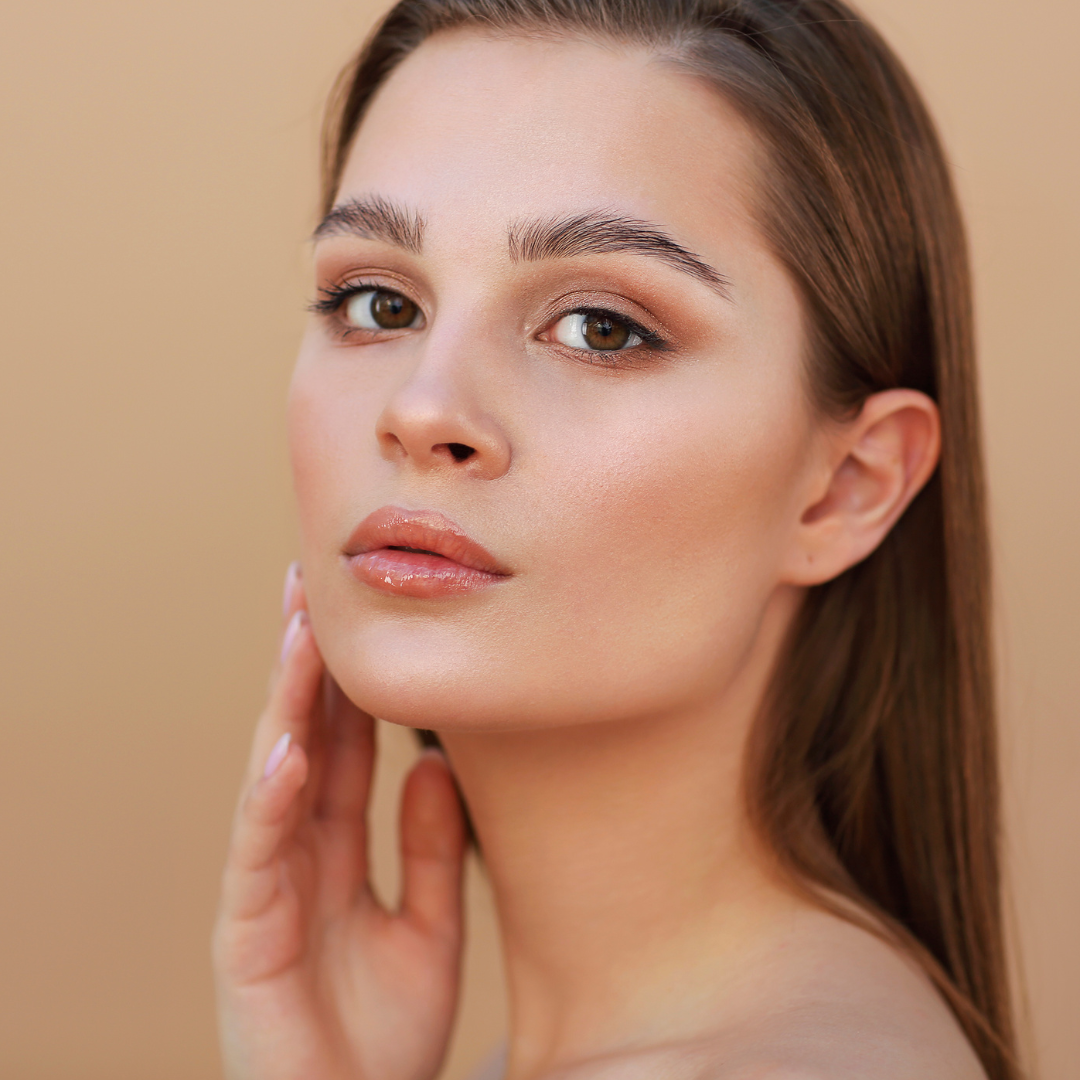
Facelift Specialist Nederland: Veiligheid & Vertrouwen
Als hoofd Plastische Chirurgie aan het LUMC brengt Dr. Verduijn de hoogste academische standaarden naar zijn privépraktijk. Europees gecertificeerd en aangesloten bij alle relevante vakorganisaties. Elke facelift wordt uitgevoerd in gecertificeerde operatiekamers met ervaren anesthesieteams. Jouw veiligheid staat altijd voorop. Door zijn uitgebreide ervaring in complexe reconstructieve chirurgie beheerst Dr. Verduijn alle aspecten van gezichtschirurgie tot in perfectie. Vertrouwen begint bij bewezen expertise en onberispelijke veiligheidsprotocollen.

Facelift Technieken: Moderne Chirurgie
Dr. Verduijn beheerst moderne chirurgische technieken waarbij verschillende weefsellagen optimaal worden behandeld. Zijn methodes bieden natuurlijke en langdurige resultaten. Ideaal voor uitgebreidere verjonging.
Het Superficial Muscular Aponeurotic System vormt de basis voor duurzame facelift resultaten. Dr. Verduijn past deze bewezen techniek toe voor optimale ondersteuning van het lifteffect.
Jarenlange ervaring in reconstructieve gezichtschirurgie geeft Dr. Verduijn unieke kennis van gezichtsanatomie. Deze diepgaande expertise resulteert in harmonieuze facelift resultaten die respecteren wat de natuur heeft gegeven.
Geen twee gezichten zijn identiek. Dr. Verduijn analyseert jouw unieke anatomie en past facelift technieken dienovereenkomstig aan. Van conservatieve mini facelift tot uitgebreide volledige facelift.

Beste Facelifts en aanvullende Behandelingen
Complementaire Procedures: Vaak wordt een facelift gecombineerd met ooglidcorrectie, wenkbrauwlift of halslift voor harmonieus totaalresultaat. Dr. Verduijn adviseert welke combinaties optimaal zijn.
Niet-chirurgische Opties: Voor subtielere verjonging biedt de praktijk ook injectables en andere behandelingen. Tijdens consult bespreken we alle mogelijkheden van minimaal invasief tot volledige facelift.

